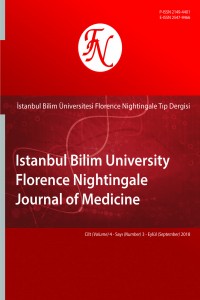Öz
Objectives: This study aims to detect the maximum permissible activity (MPA) in patients with unresectable liver metastasis and hepatocellular carcinoma treated with Yttrium-90 (Y-90) microspheres and to evaluate the absorbed radiation doses with patient-specific dosimetry methods.
Materials and methods: A total of 31 patients (20 males, 11 females; mean age 47±0.2 years; range, 32 to 62 years) were applied dosimetry. Empiric, body surface area (BSA), Medical Internal Radiation Dose (MIRD) and partition internal dosimetry models were used to calculate the MPA to deliver the maximum absorbable dose to the tumor while reducing the absorbed dose by the critical organs.
Results: Mean Y-90 activity was 57483±7.7 megabecquerel (MBq) for empiric model, 1806.04±1.37 MBq for BSA, 1649.60±1.3 MBq for MIRD, and 1658.71 MBq for partition. Mean absorbed dose calculated according to empiric model was 40.14±0.20, 197.62±0.45 and 7.39±0.08 gray (Gy) for normal liver, tumor and lung, respectively. Mean absorbed dose calculated according to BSA was 33.61±0.18, 167.83±0.41, 6.39±0.08 Gy for normal liver, tumor and lung, respectively. Mean absorbed dose calculated according to MIRD was 29.63±0.17, 125.62±0.36 and 5.67±0.07 Gy for normal liver, tumor and lung, respectively. Mean absorbed dose calculated according to partition model was 29.82±0.17, 126.72±0.36 and 5.72±0.07 Gy for normal liver, tumor and lung, respectively.
Conclusion: Since the MPAs calculated according to empiric and BSA models will lead to organ toxicity by forming high amounts of absorbed doses at critical organs, these models are not appropriate approaches for dosimetry. On the other hand, MIRD and partition models are the most successful methods for internal dosimetry applications.
Anahtar Kelimeler
Kaynakça
- 1. Breedis C, Young G.The blood supply of neoplasms in the liver. Am J Pathol 1954;30:969-77. 2. Yip D, Allen R, Ashton C, Jain S.Radiation-induced ulceration of the stomach secondary to hepatic embolization with radioactive yttrium microspheres in the treatment of metastatic colon cancer. J Gastroenterol Hepatol 2004;19:347-9. 3. Kennedy AS, Coldwell D, Nutting C, Murthy R, Wertman DE Jr, Loehr SP, et al. Resin 90Y-microsphere brachytherapy for unresectable colorectal liver metastases: modern USA experience.Int J Radiat Oncol Biol Phys 2006;65:412-25. 4. Kennedy AS, McNeillie P, Dezarn WA, Nutting C, Sangro B, Wertman D, et al.Treatment parameters and outcome in 680 treatments of internal radiation with resin 90Y-microspheres for unresectable hepatic tumors. Int J Radiat Oncol Biol Phys 2009;74:1494-500. 5. Sato K, Lewandowski RJ, Bui JT, Omary R, Hunter RD, Kulik L, et al.Treatment of unresectable primary and metastatic liver cancer with yttrium-90 microspheres (TheraSphere): assessment of hepatic arterial embolization.Cardiovasc Intervent Radiol 2006;29:522-9. 6. Gulec SA, Fong Y. Yttrium 90 microsphere selective internal radiation treatment of hepatic colorectal metastases. Arch Surg 2007;142:675-82. 7. Geschwind JF, Salem R, Carr BI, Soulen MC, Thurston KG, Goin KA, et al.Yttrium-90 microspheres for the treatment of hepatocellular carcinoma. Gastroenterology 2004;127:194-205. 8. Austin-Seymour MM, Chen GT, Castro JR, Saunders WM, Pitluck S, Woodruff KH, et al. Dose volume histogram analysis of liver radiation tolerance.Int J Radiat Oncol Biol Phys 1986;12:31-5. 9. McCammon R, Schefter TE, Gaspar LE, Zaemisch R, Gravdahl D, Kavanagh B. Observation of a dose-control relationship for lung and liver tumors after stereotactic body radiation therapy. Int J Radiat Oncol Biol Phys 2009;73:112-8. 10. SIR-Spheres®. Available from: http://www.radmed.com.tr/usr_img/sir_spheres/pdf/package_insert_sirtex.pdf. [Access: April 2005] 11. SIR-Spheres® Y-90 resin microspheres, (CR2189). Available from: https://www.sirtex.com/media/155126/ssl-us-13.pdf [Access: February 2017]. 12. ahin B, Aslan H, Ünal B, Canan S, Bilgic S, Kaplan S, Tumkaya L. Brain volumes of the lamb, rat and bird do not show hemispheric asymmetry: a stereological study, Image Anal Stereol 2001;20:9-13. 13. Güleç SA, Mesoloras G, Stabin M. Dosimetric techniques in 90Y-microsphere therapy of liver cancer: The MIRD equations for dose calculations. J Nucl Med 2006;47:1209-11. 14. Mayhew TM, Olsen DR.Magnetic resonance imaging (MRI) and model-free estimates of brain volume determined using the Cavalieri principle. J Anat 1991;178:133-44. 15. Pakkenberg B. Stereological quantitation of human brains from normal and schizophrenic individuals. Acta Neurol Scand Suppl 1992;137:20-33. 16. Mackay CE, Pakkenberg B, Roberts N. Comparison of compartment volumes estimated from MR images and physical sections of formalin fixed cerebral hemispheres. Acta Stereol 1999;18:149-59. 17. Gandhi SJ, Babu S, Subramanyam P, Shanmuga Sundaram P.Tc-99m macro aggregated albumin scintigraphy - indications other than pulmonary embolism: A pictorial essay. Indian J Nucl Med 2013;28:152-62. 18. Synder WS, Ford MR, Warner GG, Watson SB. ”S” absorbed dose per unit cumulative activity for selected radionuclides and organs NM/MIRD. New York: Society of Nuclear Medicine; 1975. 19. Austin-Seymour MM, Chen GT, Castro JR, Saunders WM, Pitluck S, Woodruff KH, et al. Dose volume histogram analysis of liver radiation tolerance. Int J Radiat Oncol Biol Phys 1986;12:31-5. 20. McCammon R, Schefter TE, Gaspar LE, Zaemisch R, Gravdahl D, Kavanagh B. Observation of a dose-control relationship for lung and liver tumors after stereotactic body radiation therapy. Int J Radiat Oncol Biol Phys 2009;73:112-8. 21. Gulec SA, Mesoloras G, Dezarn WA, McNeillie P, Kennedy AS. Safety and efficacy of Y-90 microsphere treatment in patients with primary and metastatic liver cancer: the tumor selectivity of the treatment as a function of tumor to liver flow ratio. J Transl Med 2007;5:15. 22. Weber DA, Eckeman KF, Dillman LT, Ryman JC. MIRD: radionuclide data and decay schemes. New York: Society of Nuclear Medicine; 1989. 23. Snyder WS, Ford MR, Warner GG, Watson SB. ‘S,’ absorbed dose per unit cumulated activity for selected radionuclides and organs MIRD Pamphlet 11 (Reston, VA: Society of Nuclear Medicine) 1975;1-258. 24. Jabbari K. Review of fast monte carlo codes for dose calculation in radiation therapy treatment planning. J Med Signals Sens 2011;1:73-86. 25. Ho S, Lau WY, Leung TW, Chan M, Ngar YK, Johnson PJ, et al. Partition model for estimating radiation doses from yttrium-90 microspheres in treating hepatic tumours. Eur J Nucl Med 1996;23:947-52.
Ayrıntılar
| Birincil Dil | İngilizce |
|---|---|
| Bölüm | Makaleler |
| Yazarlar | |
| Yayımlanma Tarihi | 14 Ekim 2018 |
| Yayımlandığı Sayı | Yıl 2018 Cilt: 4 Sayı: 3 |


